Hyundai Solaris sedan has been produced since January 2011
In May 2011, the production of a hatchback car began
Hyundai Solaris was developed on the basis of Hyundai Verna (fourth generation Accent) specifically for Russia: numerous options are selected exclusively for Russian consumers.
The car belongs to the compact class (according to the European classification class C) and complies with European environmental standards Euro-4.
The car is equipped with gasoline engines of 1.4 liters (107 hp) and 1.6 liters (123 hp), equipped with a five-speed manual or four-speed automatic transmission.
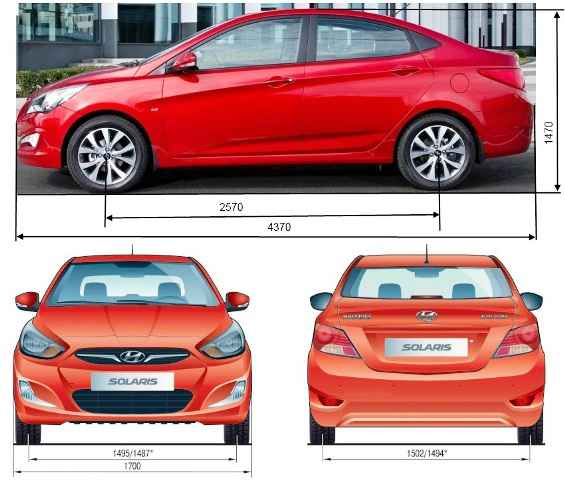
The overall dimensions of the car are shown in the figures.
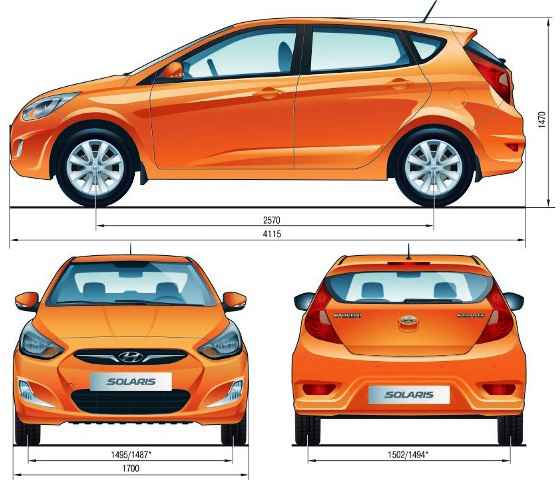
Vehicle specifications
The curb weight of the car is 1110-1198 kg
Gross vehicle weight 1565 kg.
Four-stroke gasoline engine with two camshafts (DOHC), with CWT electronic phase control
Number, four-row arrangement of cylinders.
Compression ratio 10.5
Transmission
Clutch with manual gearbox, single plate, dry, with diaphragm pressure spring and torsional vibration damper
Clutch release drive hydraulic, backlash-free
Gearbox:
Mechanical M5CF1-1 five-speed manual with synchronizers in all forward gears
Gear ratios:
- I - 3.615
- II - 1,950
- III - 1.370
- IV - 1,031
- V - 0.837
- Rear. stroke - 3,583
Ratio final drive 4.294
Automatic A4CF1 four-speed, hydromechanical, adaptive
Gear ratios:
- I - 2.919
- II - 1.551
- III - 1,000
- IV - 0.713
Ratio final drive 4.619
Wheel drive front, open, shafts with constant velocity joints
Chassis

Location of components and assemblies of a car with a 1.4 liter engine (bottom view, engine crankcase protection removed): 1, 15 - mudguards; 2 - windshield washer reservoir: 3 - front wheel liner; 4 - front suspension spring: 5 - auxiliary drive belt; 6 - water pump; 7 - drain plug; 8 - oil filter; 9 - oil pressure sensor; 10 - crankshaft position sensor; 11 - working cylinder of the clutch release drive; 12 - clutch release fork; 13 - gearbox; 14 - intake silencer; 16, 35 - ball bearings; 17, 34 - front wheel brakes; 18, 33 - tie rod ends; 19, 32 - anti-roll bar; 20, 31 - front suspension shock absorbers; 21, 29 - front suspension arms; 22 - left front wheel drive; 23 - rear suspension support of the power unit; 24 - diagnostic oxygen concentration sensor; 25 - cross member of the front suspension; 26 - cylinder block; 27 - drive of the right front wheel; 28 - engine oil pan; 30 - dynamic damper
Independent front suspension, MacPherson type, with hydraulic shock struts, coil springs and anti-roll bar
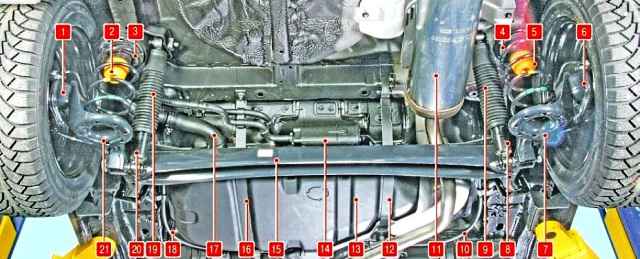
The main units of the car (bottom rear view): 1, 6 - brake shields; 2, 5 - compression stroke buffers; 3, 4 - rear suspension springs; 7, 21 - lower supports of the rear suspension spring; 8, 20 - rear suspension shock absorbers; 9, 19 - protective covers; 10, 18 - parking brake cables; 11 - muffler; 12, 16 - clamps for fastening the fuel tank; 13 - fuel tank; 14 - adsorber; 15 - rear suspension beam; 17 - filling pipe
Rear suspension semi-independent, with coil springs, hydraulic shock absorbers
Steel disc wheels, stamped or cast, light alloy 185x65 R15 or 195/55 R16
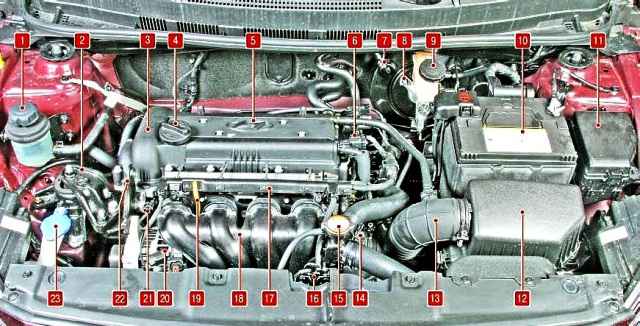
Engine compartment of a car with a 1.4 liter engine: 1 - plug of the power steering reservoir; 2 - right suspension support of the power unit: 3 - engine cylinder head cover; 4 - oil filler cap; 5 - cover of candle wells; 6 - camshaft position sensor; 7 - vacuum brake booster; 8 - main brake cylinder; 9 - reservoir of the master brake cylinder (and the clutch release master cylinder for vehicles with manual gearboxes); 10 - battery; 11 - mounting block of relays and fuses; 12 - air filter housing; 13 - air supply sleeve; 14 - throttle assembly; 15 - plug of the radiator of the engine cooling system; 16 - hood lock; 17 - fuel rail; 18 - inlet pipe; 19 - oil level indicator (oil dipstick); 20 - generator; 21 - solenoid valve of the CWT system; 22 - transport eye; 23 - washer reservoir neck
The elements of the car, located in the engine compartment, and the main units are shown in the figures.
|
With 1.4 CWT engine |
With 1.6 CWT engine |
|---|---|
|
Maximum vehicle speed with manual transmission |
|
|
190 |
190 |
|
Maximum vehicle speed with automatic transmission |
|
|
170 |
180 |
|
Time to accelerate the car to 100 km / h, sec. with MCP |
|
|
11.5 |
10.2 |
|
Time to accelerate the car to 100 km / h, sec. with automatic transmission |
|
|
13.2 |
11.2 |
|
Fuel consumption with manual gearbox l/100 km urban |
|
|
7.6 |
7,9 |
|
Fuel consumption with manual gearbox l/100 km extra-urban |
|
|
5.2 |
5.2 |
Vehicle passport details
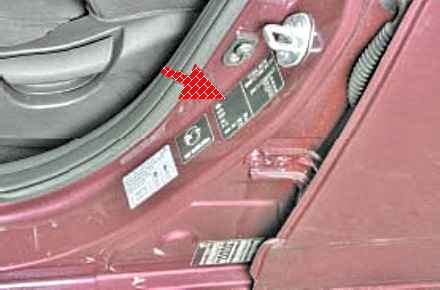
Vehicle Identification Number (VIN) assigned by the car assembly plant, factory name and vehicle specification are indicated on the identification plate affixed to the left B-pillar of the car body.
This identification number, when registering a car with the traffic police, is entered in the "VIN-code" column.
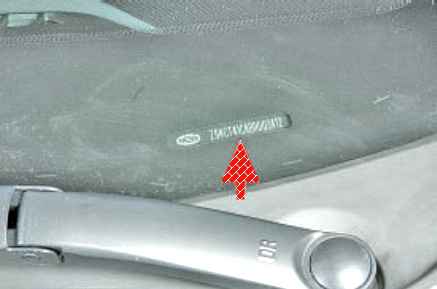
Vehicle identification number is duplicated on a plate attached to the top of the instrument panel and on the floor (stamped) under the floor mat on the front passenger side.

In order to read the hallmarked identification number, you must move the seat back and lift the cutout of the rug.
The illustration shows the vehicle information contained in the identification plate affixed at the factory to the left B-pillar.
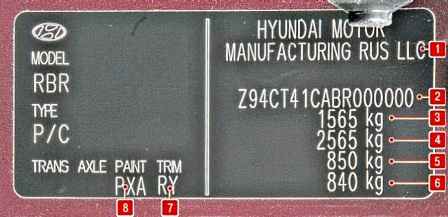
Identification plate: 1 - manufacturer; 2 - vehicle identification number (VIN); 3 - permitted maximum vehicle weight; 4 - gross vehicle weight with a trailer; 5 - permissible load on the front axle of the car; 6 - permissible load on the rear axle of the car; 7 - car interior color code; 8 - car body color code
Deciphering the identification number, for example, X94CT41CABR000000:
- X94 is the international code of the manufacturer (Hyundai Motor Manufacturing Rus LLC);
- CT - vehicle model designation (Solaris);
- 41 - body type (four-door sedan);
- C – engine type;
- A – gearbox type;
- B – model year code of the car;
- R - manufacturer's code;
- 000000 is the serial number of the car.
The designation (model and main characteristics) of the engine is stamped on the tide of the cylinder block next to the starter.
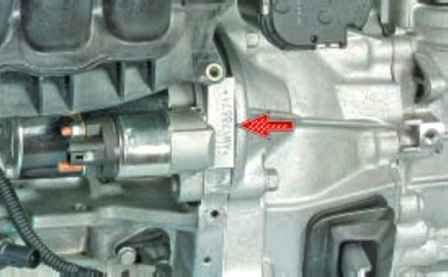
Deciphering the engine designation, for example, G4FA AW000000:
- G - petrol;
- 4 is the number of engine cylinders;
- FA - code of displacement and engine type;
- A is the year of manufacture of the engine;
- W – manufacturer's code;
- 000000 is the serial number of the engine.
|
1.4 CWT engine |
1.6 CWT engine |
|---|---|
|
Cylinder diameter x stroke, mm |
|
|
77x74.49 |
77x85.44 |
|
Displacement, cm3 |
|
|
1396 |
1591 |
|
Maximum power, hp |
|
|
107 |
123 |
|
Crankshaft speed at maximum power, min-1 |
|
|
6300 |
6300 |
|
Maximum torque, Nm |
|
|
135.4 |
155 |
|
Crankshaft speed at maximum torque, min-1 |
|
|
5000 |
4200 |





